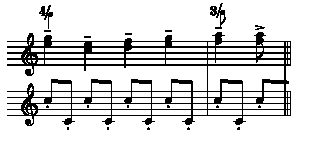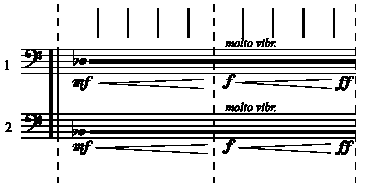
6.1. Meter indications are always written between blank spaces unless combined with a key signature. The note following a meter must always have an octave mark.
6.2. (11-97) Meter indications that contain note values are written with the music prefix separating the number from the note value which is written as the note C.
Example 6.2-1.
#D,'?
.>_8_8.\++$]\ #C,'D _8.[.8I+<K
_>'88.D"D777 #C,'D .D"D<18.D<K

6.3. Changes of meter are treated in the same manner as that explained above (Par. 5.4) for changes of key.
Example 6.3-1.
#C4
"$\.? #B4 "JE"] FH: #C4 "$\.$
#B4 .E"IW IF\<K
![]()
6.4. (11-97) As shown in Table 6, meter indications may be combined. If the second indication is in parentheses in print, the braille copy should follow suit. When the music parentheses are used, no space is necessary between the two signatures.
6.5. When meter indications are shown with literary punctuation, the indicator and special comma are used as explained in Note 5, page 3. Thus this text:
…time signatures are 2/4, 3/4, 6/8, and 9/8
...would be brailled as follows:Example 6.5-1
''' "T SIGNATURES >E ,'#B4, #C4,
#F8, ;2& ,'#I8_4 '''
(The same procedure may be used where chord symbols are shown with literary punctuation.)
6.6. When a meter indication contains more than one number above, and a single number below, the braille follows the print exactly. Print punctuation, if used, is included in the braille. If punctuation or other print signs appear between the numbers, a single number sign is brailled at the beginning of the meter signature, no spaces are inserted, and the final lower-cell number is placed unspaced at the end. If no punctuation or other print signs appear between the numbers, the number sign is repeated, unspaced, for each upper number but not before the lower number.
Example 6.6-1.
|
#B+B+C8 |
|
|
#B#C#B8 |
|
6.7. In music with no meter signature, numbers and/or horizontal lines of extension often indicate that notes, chords or rests should be held for a period of time. The numbers indicate seconds of actual time and are printed larger than fingering numbers or are positioned in such a way as to avoid confusion with fingering. In the following example, the pause is to last six seconds and is followed by a note that should be held for five seconds.
Example 6.7-1.
;<L^#F .Y^#E<K

6.8. Seconds of time may also be indicated with short vertical print lines usually placed above the staff. In braille the sign for a second (dots 45) must be preceded and followed by a space unless accompanied by a number. In that case, the sign for a second precedes the number sign. If the duration of time is shown in print with a line of extension and no number, the line of duration appears in braille (see Table 6 B). This line must be preceded and followed by a space. In the following example for two cellos, the marginal indications show that this excerpt begins 10 seconds into the composition and that the second parallel begins 5 seconds later.
Example 6.8-1.
^#AJ ^ ^ ^ ^
>VC1'>MF>C'5AA<_E -- -- -- K
>VC2'>MF>C'5AA<^J -- -- -- K
^#AE ^ ^ ^ ^
>VC1 7MOLTO VIB'7 >F>C -- -- >FF -- K
>VC2 7MOLTO VIB'7 >F>C -- -- >FF -- K

6.9. When music contains some passages with meter signatures and some without, the phrase "time notation" is inserted where appropriate.